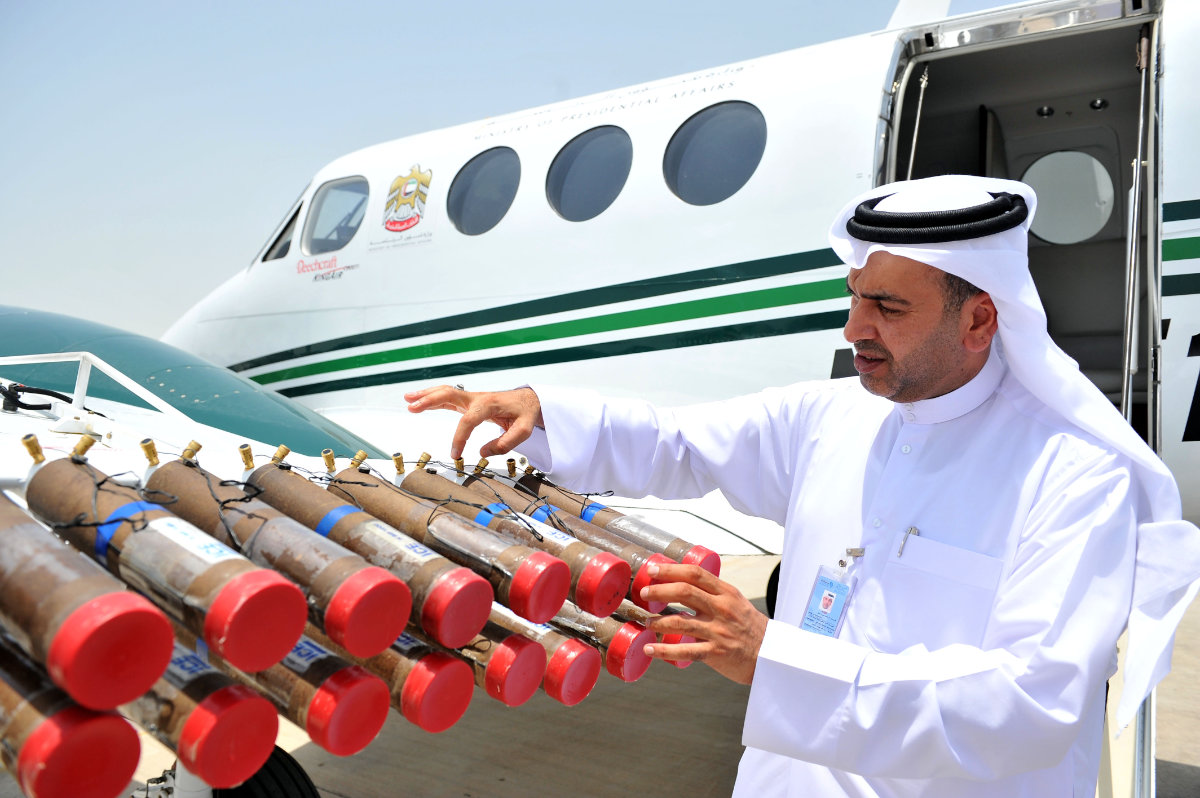How can artificial rain change the water situation in Saudi Arabia and the Gulf region?
JEDDAH: To meet the growing demand for fresh water in Saudi Arabia, officials have launched a project that will change the composition of clouds to increase rainfall; A technique known as cloud seeding.
With a long-term average rainfall of less than 100 mm a year, a growing population and a growing agricultural sector, Saudi Arabia is in extreme thirst for more fresh water. That’s why, in early April, the state began the first phase of a cloud-seeding program to change the amount and type of rainfall.
Following the approval of the plan by the Saudi government, an aircraft was deployed into the sky over the vast rocky Najd plateau in the central region of the kingdom, where it released heaps of silver iodide into the clouds. This led to the formation of ice crystals in the clouds, encouraging rainfall in the target areas. The process began in the Riyadh region and will soon spread to other sites in Asir, Baha and Taif.
“The state is considered one of the least rainfed countries, with an average annual rainfall of 100 mm,” Ayman Ghulam, chief executive officer of the National Meteorological Center, said during a conference in Riyadh in March. “Cloud seeding is one of the most promising solutions in Saudi Arabia.”
The National Artificial Rainfall Program with an aim to increase rainfall by 20 per cent is expected to continue for five years. It is part of the Saudi Green Initiative, which was launched in March 2021 by Crown Prince Mohammed bin Salman to promote sustainable development and environmental protection, and to secure natural water sources in the Kingdom.
Roulof Bruntjes, who leads the weather modification group at the US National Center for Atmospheric Research, said the Kingdom is using a well-established method of cloud seeding that is harmless to the environment.
The two seeding agents used in Saudi operations are hygroscopic (meaning substances that absorb moisture from the air) materials such as salts and silver iodide. They are employed in such low concentrations that they are largely undetectable, and have been used for nearly 40 years in cloud-seeding projects in the western US, where drought is prevalent.
The success of a cloud-seeding operation, Bruntjes said, depends in part on the characteristics of the clouds.
“No cloud is like another cloud and no cloud will ever be like another,” he told Arab News.
“In Saudi Arabia, most of your clouds that are in the central region and southwest are more convective type clouds. In this way, we mostly use hygroscopic cells to make larger droplets so that they can more easily collide with each other and stop the rain, so you get more water that is processed into the cloud below at the surface .

Cloud seeding is seen as a viable, eco-friendly way to increase water supplies in Saudi Arabia in the future, as climate change makes the precious resource even more scarce. (Saudi National Center of Meteorology)
“You’re basically trying to get more water out of the clouds to increase the percentage of water from cloud processes coming to the surface.”
Water covers about 71 percent of the Earth’s surface, but the Middle East and North Africa region has very few life-supporting resources. According to the United Nations, it is the world’s most water-scarce region, with 17 countries considered below the water-poverty line.
Rapid population growth, poor infrastructure and over-exploitation of limited resources have made the situation worse. According to the World Bank, agriculture alone accounts for about 80 percent of water use in the Middle East and North Africa region.
Innumbers
50 Countries want to establish rainfall-enhancement programmes.
20% Targeted increase in KSA rainfall through cloud seeding.
18% Saudi share in the global production of desalinated seawater.
This overuse means that the area’s natural groundwater reserves are not being replenished fast enough to keep pace with demand. Deficiency can have widespread human consequences, with drought destroying livelihoods and displacing populations from rural to urban areas.
Around 1.1 billion people worldwide do not have reliable access to water, and 2.7 billion face water scarcity for at least one month of the year. By 2025, an estimated two-thirds of the global population could face water scarcity.
Forecasts suggest that water supplies will decline dramatically by 2030 and rationing could be the new normal unless sustainable solutions are implemented.
The United Nations has classified Saudi Arabia and most other Gulf countries as water deficient. The exception is Oman, which sits slightly above the limit of severe water shortages of 500 cubic meters per person per year.
Studies have shown that the Middle East may be one of the worst affected by climate change. They caution that conditions are favorable for a process known as photochemical air pollution, which combines increased and high concentrations of aerosol particles from both natural, such as desert dust, and artificial, such as pollution, sources.

Aerosols are blamed as causes of climate change, which affect the way clouds form. (shutterstock photo)
“The Middle East is the crossroads of the world,” Bruntjes said. “You get pollution from India in summer, due to easterly winds, and in winter you probably get some frontal systems from Eastern Europe and the Mediterranean.
“Aerosols don’t know boundaries, clouds don’t know boundaries, pollution doesn’t know boundaries.”
It is because of these man-made and environmental factors that cloud seeding is seen as a particularly effective solution for this particular area.
“The effects of biomass fumes from Africa, the penetration of Sahara dust into that region, are things that we will evaluate as part of any cloud seeding experiment,” Bruntjes said.
“Dust particles only interact with clouds to form ice crystals, not droplets. However, leaching out in the oil industry produces more sulfate than nitrate – tiny particles that can normally block precipitation – and This is where cloud seeding can come in.

An Emirati pilot prepares his plane for a cloud-seeding operation. (AN file photo)
Saudi Arabia has no permanent natural lakes or rivers, and no areas of abundant natural vegetation, with the exception of its southwestern Asir Highlands.
Over the past three decades, the state was exploiting its underground reserves, known as aquifers, for agricultural purposes. As a result, they have decreased from 166 cubic meters of per capita renewable internal freshwater resources in 1987 to just 71 cubic meters in 2018.
The country has therefore been forced to rely largely on imports and desalination of seawater to meet the demand.
A 2018 United Nations study found that there are 16,000 desalination plants operating in 177 countries, producing an amount of fresh water equal to about half the average flow of Niagara Falls. Saudi Arabia has one of the largest desalination plants in the world.

Without natural, permanent rivers or lakes, Saudi Arabia has pioneered water desalination, including its plant in the industrial city of Jubail. (AFP)
However, research has shown that desalination plants are inevitably linked to environmental issues, including air pollution, making their long-term use untenable if the world hopes to reduce harmful greenhouse-gas emissions.
Saudi Arabia has decades of experience in water desalination, beginning with the opening of the country’s first facility in the 1950s. As new technologies are developed to reduce emissions, the Kingdom has adopted solar power and other renewable energy to power its desalination plants.
Still, if the country is to meet the ever-increasing demand for water and refill its aquifers, appropriate scale alternatives must be developed. Along with ground-based seeding generators, cloud seeding is seen as a potential way to top up depleting reserves.
Saudi Arabia is only the second country in the Gulf region to launch a cloud-seeding program, after the United Arab Emirates. However, many other drought-affected countries around the world have adopted the technology to help modify the weather and replenish natural water supplies.
The ability to predict the distribution and intensity of precipitation over the Gulf and wider MENA regions could prove important in the coming years as climate change results in more frequent droughts.

